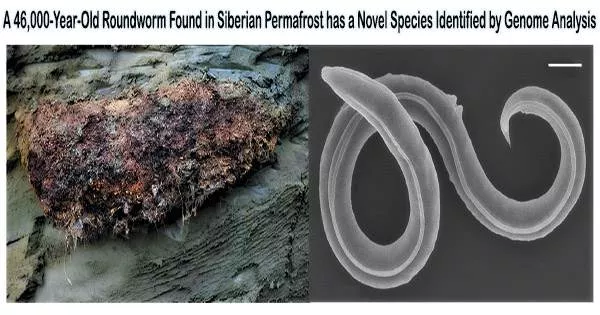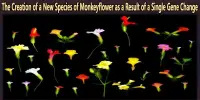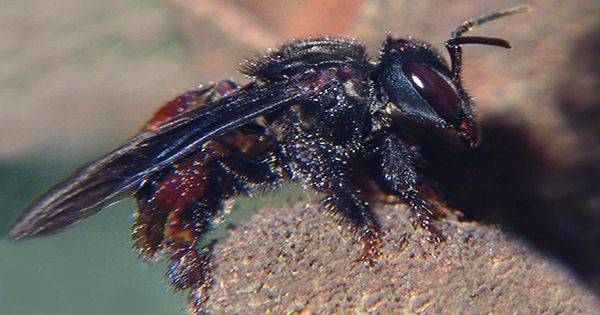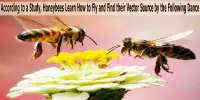Some creatures, such tardigrades, rotifers, and nematodes, may endure harsh environments by going into a latent state known as “cryptobiosis.”
In the Siberian Permafrost, two species of roundworms (nematodes) were discovered in 2018 by researchers from the Institute of Physicochemical and Biological Problems in Soil Science RAS in Russia. The nematode individuals have been in cryptobiosis since the late Pleistocene, or roughly 46,000 years ago, according to radiocarbon dating.
Researchers from the Max Planck Institute of Molecular Cell Biology and Genetics (MPI-CBG) in Dresden, the Center for Systems Biology Dresden (CSBD), and the Institute of Zoology at the University of Cologne, all located in Germany, used genome sequencing, assembly, and phylogenetic analysis and found that the permafrost nematode belongs to a previously undescribed species, Panagrolaimus kolymaensis.
They demonstrated that Panagrolaimus kolymaensis used identical biochemical pathways to withstand desiccation and freezing in a lab setting as a stage in the significant biological model Caenorhabditis elegans. Their research has been published in PLoS Genetics.
Anastasia Shatilovich and her colleagues at the Institute of Physicochemical and Biological Problems in Soil Science RAS in Russia were ecstatic when she successfully thawed two frozen individual worms from a fossilized tunnel in silt deposits in the Siberian permafrost.
After thawing the worms in the lab, a radiocarbon analysis of plant material from the burrow revealed that these frozen deposits, 40 meters below the surface, had not thawed since the late Pleistocene, between 45,839 and 47,769 years ago.
Our findings are essential for understanding evolutionary processes because generation times can range from days to millennia and because the long-term survival of a species’ individuals can result in the re-emergence of lineages that would otherwise have gone extinct.
Philipp Schiffer
At the same time, the research group of Teymuras Kurzchalia at the MPI-CBG was already addressing the question of how larval stages of the nematode Caenorhabditis elegans survive extreme conditions. When the team heard about the permafrost nematodes, they immediately reached out for a collaboration with Anastasia Shatilovich.
Vamshidhar Gade, a doctoral student at that time in the research group of Teymuras Kurzchalia, started to work with the permafrost nematodes. “What molecular and metabolic pathways these cryptobiotic organisms use and how long they would be able to suspend life are not fully understood,” he says. Vamshidhar is now working at the ETH in Zurich, Switzerland.
The researchers in Dresden conducted a high-quality genome assembly of one of the permafrost nematodes in collaboration with Eugene Myers, Director Emeritus and research group leader at the MPI-CBG, the DRESDEN-concept Genome Center, and the research group of Michael Hiller, research group leader at that time at the MPI-CBG and now Professor of Comparative Genomics at the LOEWE-TBG and the Senckenberg Society for Nature Research.
Although DNA barcoding sequences and microscopic images were available, it was challenging to identify whether the permafrost worm belonged to a new species. Philipp Schiffer, research group leader at the Institute of Zoology, co-lead of the incipient Biodiversity Genomics Center Cologne (BioC2) at the University of Cologne, and expert in biodiversity genomics research, joined forces with the Dresden researchers to determine the species and analyze its genome with his team.
He and his team were able to categorize the roundworm as a distinct species using phylogenomic research, and they chose to name it “Panagrolaimus kolymaensis.” The nematode’s Latin name, Kolymaensis, honors the area along the Kolyma River where it first appeared.
The genomes of Panagrolaimus kolymaensis and the model nematode Caenorhabditis elegans were compared, and the researchers in Cologne discovered genes involved in cryptobiosis that are shared by both species.
To their surprise, most of the genes necessary for entering cryptobiosis in Caenorhabditis elegans so-called Dauer larvae were also present in Panagrolaimus kolymaensis. The scientists next examined Panagrolaimus kolymaensis’s capacity for survival and found that a brief exposure to mild dehydration before to freezing helped the worms become ready for cryptobiosis and boosted survival at -80° Celsius.
Both species produced trehalose when mildly dehydrated in the lab, which may have given them the ability to withstand freezing and severe dehydration. Caenorhabditis elegans larvae also benefited from this treatment, surviving for 480 days at -80° Celsius without suffering any declines in viability or reproduction following thawing.
According to Vamshidhar Gade and Temo Kurzhchalia, “Our experimental findings also show that Caenorhabditis elegans can remain viable for longer periods in a suspended state than previously documented. Overall, our research demonstrates that nematodes have developed mechanisms that allow them to preserve life for geological time periods.”
“Our findings are essential for understanding evolutionary processes because generation times can range from days to millennia and because the long-term survival of a species’ individuals can result in the re-emergence of lineages that would otherwise have gone extinct,” concludes Philipp Schiffer, one of the authors who oversaw the study.
Eugene Myers adds, “P. kolymaensis’s highly contiguous genome will make it possible to compare this feature to those of other Panagrolaimus species whose genomes are presently being sequenced by Schiffer’s team and colleagues.”
Philipp Schiffer is convinced that “studying the adaptation of species to such extreme environments by analyzing their genomes will allow us to develop better conservation strategies in the face of global warming.”
Teymuras Kurzchalia says, “This study extends the longest reported cryptobiosis in nematodes by tens of thousands of years.”
















